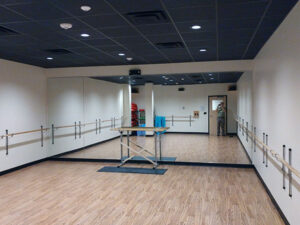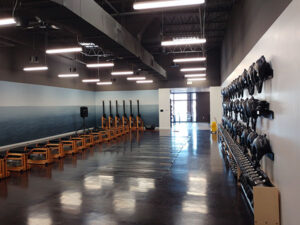Fitness Center Acoustics
Fitness center acoustics and noise issues have been the subject of numerous AVANT ACOUSTICS projects over the years. The hard surfaces and loud activity make the perfect storm of noise. As a result, people within the fitness center often cannot communicate effectively. The noise may also disturb the neighbors! This article explores some of the common acoustical problems we see, and shares possible solutions.
Fitness Center Room Acoustics
Fitness centers often have many hard surfaces with little absorption. This results in overly reverberant spaces that can cause a build-up of noise. This also can negatively impact speech intelligibility, making it difficult for instructors to communicate. It can even result in hearing damage!
However, proper acoustical absorption and finish selection can help to create an appropriate acoustical environment that supports clear communication and participant engagement. An acoustical consultant can determine the appropriate type and location of treatment.
Noise Control
Neighbors do not want to hear music or an instructor’s directions! Noise transmission into adjacent spaces can occur through walls, floors, or ceilings. However, constructing walls, floors, and ceilings with sufficient mass can attenuate and control noise.
Vibration Control
In fitness centers, exercise equipment, dropped weights, and even percussive-style workouts can create vibration. Vibration can then transmit through the building structure and re-radiate as noise in adjacent (or even faraway) spaces.
However, there are ways to control this sound. Use rubber mats, resilient underlayment, or even floating floors to dampen these impacts. The degree of vibration control needed depends on the type of vibration or impacts anticipated.
Mechanical Noise
Sometimes, excessive noise from HVAC units makes instruction and communication difficult within a fitness center. To overcome the HVAC noise, fitness centers often turn up their sound systems, leading to increased complaints from neighbors. Instead, try using duct lining and/or duct silencers to provide proper HVAC noise levels.
Fitness Center Sound Systems
Fitness centers do not need blaring music to motivate participants. A well-tuned sound system designed to cover the appropriate areas generally does not need to be loud for effective communication. Properly aiming the sound at the intended coverage areas so that it doesn’t spill over onto walls can also help reduce noise transmission out of the space.
If you own a fitness center or similar facility, carefully consider all of these aspects, and contact an acoustical consultant for help. The result will be a pleasing and effective environment for fitness classes.
This post was authored by AVANT ACOUSTICS Senior Associate, Andrew VonFeldt.




